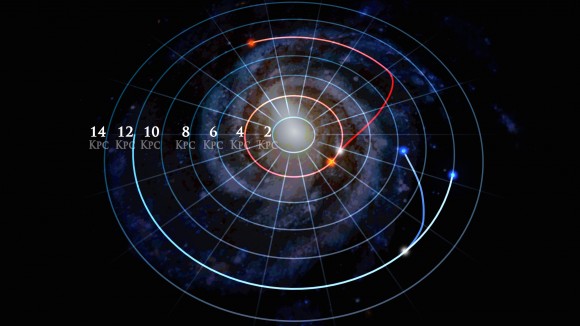Third of Milky Way stars have changed orbit
Astronomers have created a new
map of the Milky Way that shows that about 30 percent of the stars have
traveled a long way from the orbits they were born with.

This
image shows two pairs of stars (marked as red and blue) in which each
pair started in the same orbit, and then one star in the pair changed
orbits. The star marked as red has completed its move into a new orbit,
while the star marked in blue is still moving. Image credit: Dana
Berry/SkyWorks Digital, Inc.; SDSS collaboration)
Michael Hayden, an astronomy graduate student at New Mexico State University, is lead author of the study. Hayden said:
In our modern world, many people move far away from their birthplaces, sometimes halfway around the world. Now we’re finding the same is true of stars in our galaxy – about 30 percent of the stars in our galaxy have traveled a long way from where they were born.To build the new map of the Milky Way, scientists used a spectrograph on the SDSS Apache Point Observatory in New Mexico to observe 100,000 stars during a 4-year period.
The key to creating and interpreting this map of the galaxy is measuring the elements in the atmosphere of each star. Hayden said:
From the chemical composition of a star, we can learn its ancestry and life history.The chemical information comes from spectra, which are detailed measurements of how much light the star gives off at different wavelengths. Spectra show prominent lines that correspond to elements and compounds. Astronomers can tell what a star is made of by reading these spectral lines.
Continue Reading at .... http://earthsky.org/space/one-third-of-milky-way-stars-have-moved